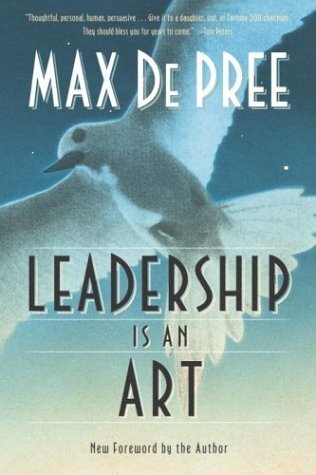Max Depree, Leadership is an Art. Crown Business, 2004.
Referenced in: Empowering Leadership
LifeandLeadership.com Summary
This is one of the most widely read examples of transformational, empowering and servant leadership models. It is the first of De Pree’s books on leadership, followed by Leadership Jazz and Leading Without Power.
In this volume, De Pree writes about the art of leadership: liberating people to do what is required of them in the most effective and humane way possible. (p. 1) The best way to suggest the value of this book, which enjoys wide readership among Christian leaders and leadership coaches, is to list a few sample pieces. These ought to whet your appetite:
“The first responsibility of a leader is to define reality. The last is to say thank you. In between the two, the leader must become a servant and debtor. That sums up the progress of an artful leader.” (11)
“The measure of leadership is not the quality of the head, but the tone of the body. The signs of outstanding leadership appear primarily among the followers. Are the followers reaching their potential? Are they learning? Serving? Do they achieve the required results? Do they change with grace? Manage conflict?” (12)
“Leaders are obligated to provide and maintain momentum.” (17)
“Participative management arises out of the heart and out of a personal philosophy about people. It cannot be added to or subtracted from, a corporate policy manual as though it were one more managerial tool.” (24)
“The best people working for organizations are like volunteers. Since they could probably find good jobs in any number of groups, they choose to work somewhere for reasons less tangible than salary or position. Volunteers do not need contracts, they need covenants. Covenantal relationships enable corporations and institutions to be hospitable to the unusual person and to unusual ideas.” (28)
The rights of team members: 1) the right to be needed; 2) the right to be involved; 3) the right to a covenantal relationship; 4) the right to understand; 5) the right to affect one’s own destiny; 6) the right to be accountable; 7) the right to appeal; 8) the right to make a commitment. (35-43)
“Roving leaders are those indispensable people in our lives who are there when we need them. Roving leadership is the expression of the ability of hierarchical leaders to permit others to share ownership of the problems ” in effect, to take possession of them.” (48-49)
“Three of the key elements in the art of working together are how to deal with change, how to deal with conflict, and how to reach our potential. A legal contract has nothing to do with reaching our potential
Quotes Alexander Solzhenitsyn, “Whenever the tissue of life is woven of legalistic relationships, this creates an atmosphere of spiritual mediocrity that paralyzes men’s noblest impulses.” Covenantal relationships, on the other hand, induce freedom, not paralysis. A covenantal relationship rests on shared commitment to ideas, to issues, to values, to goals, and to management processes. Words such as love, warmth, personal chemistry are certainly pertinent. Covenantal relationships are open to influence. They fill deep needs and they enable work to have deep meaning and be fulfilling. Covenantal relationships reflect unity and grace and poise. They are an expression of the sacred nature of relationships.” (59-60)
Six tenets of the cost of belonging (69-70)
Giants, see opportunity where others see trouble (73) give others the gift of space (75) catch fast balls, have special gifts that enable others to express their gifts. (73-79)
Twenty signs of entropy (111-112)
List of requests he makes of each senior manager before the performance review and the questions he asks senior managers to consider. (117-120)
From the Publisher
LEADERSHIP IS AN ART has long been a must-read not only within the business community but also in professions ranging from academia to medical practices, to the political arena. First published in 1989, the book has sold more than 800,000 copies in hardcover and paperback. This revised edition brings Max De Pree’s timeless words and practical philosophy to a new generation of readers.De Pree looks at leadership as a kind of stewardship, stressing the importance of building relationships, initiating ideas, and creating a lasting value system within an organization. Rather than focusing on the ?hows? of corporate life, he explains the ?whys.? He shows that the first responsibility of a leader is to define reality and the last is to say thank you. Along the way, the artful leader must:
Stimulate effectiveness by enabling others to reach both their personal potential and their institutional potential
Take a role in developing, expressing, and defending civility and values
Nurture new leaders and ensure the continuation of the corporate culture
LEADERSHIP IS AN ART offers a proven design for achieving success by developing the generous spirit within all of us. Now more than ever, it provides the insights and guidelines leaders in every field need.
About the Author
MAX DE PREE is chairman emeritus of Herman Miller, Inc., the primary innovator in the furniture business for sixty years and regularly included as one of Fortune’s 25 Most Admired Companies in the United States. The author of the bestselling Leadership Jazz, as well as Leading Without Power, Called to Serve, and Dear Zoe, De Pree has been mentoring emerging leaders in both the profit and non-profit sectors for more than twenty years, and was elected by Fortune magazine to the National Business Hall of Fame.
***For additional information on this resource, including reviews, click the bookstore links. Check the reference at page top or the links below for resource guides on related topics.***
Related Areas
See Other Resources on Leadership:
See Resources on Over 100 Areas of Ministry Leadership:


